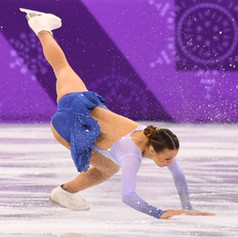Common Injuries Sustained in Winter Sports & What Treatment May Look Like
- Haley Kirk
- Feb 15, 2018
- 3 min read

After witnessing U.S. luger Emily Sweeney's crash Tuesday at the 2018 U.S. Winter Olympic Games, it was determined that although she appears to have no broken bones she is still going to undergo an X-ray to be sure. With this, articles are beginning to surface discussing how there is definitely a certain degree of danger and risk that comes with winter sports that doesn't necessarily present itself during the summer games.
(Photos courtesy of USA Today Sports)
In the winter months, we frequently see athletes or members of the active population that participate in these sports and the injuries can range from a sprained ankle, all the way to a broken back. Here are some of the most common injuries that we see sustained in these sports, and how to possibly prevent them moving forward.
Hockey & Ice Skating
Herniated discs or strain on the SI joint in lower back from falling hard on the ice
Physical therapy and gentle stretching
Heat/ice therapy
Use of anti-inflammatories
ACL/MCL tears from sudden stops add twisting when skating
Ice therapy immediately after
Wear a hinge brace for 3-6 weeks vs. surgery
Physical therapy and gentle stretching after surgery
AC joint shoulder separations from bracing a fall on the ice
Heat/ice therapy, you may return quickly with a low grade injury
Physical therapy to regain mobility and range of motion
Use of anti-inflammtories
In more severe tears, surgery to repair the joint
Skiing
Meniscus tears from twisting your knee incorrectly
Heat/ice therpy
Physical therapy to regain mobility and range of motion
Use of anti-inflammtories
In more severe grade tears, surgery to repair the tear or resection of the frayed tissue
ACL/MCL tears from landing a jump incorrectly and twisting the knee, or suddenly changing direction
Ice therapy immediately after
Wear a hinge brace for 3-6 weeks vs. surgery
Physical therapy and gentle stretching after surgery
Tibia/fibula fractures
Surgery to repair the fractures
Casting
Snowboarding
Ankle fracture (Talus bone)
Foot cast
Typically, will require surgery to correct the fracture
This is one of the most common injuries in snowboarders, and is often missed on a normal x-ray. However, here at OPA, we have a pedCAT standing x-ray machine to accurately diagnose this
Rotator cuff tears
Ice
Physical therapy to regain mobility and range of motion
Refrain from activity and overhead lifitng
Depending on the grade of the tear, you can live with a rotator cuff tear as long as it doesn't prevent you from overhead lifting or enjoying life
Clavicle fractures
Wear a sling for 4-6 weeks to protect the bone enough for healing
Ice therapy
Physical therapy to regain strength and range of motion
Depending on how misaligned the bone is when broken, surgical intervention may be necessary
ACL/MCL tears
Ice therapy immediately after
Wear a hinge brace for 3-6 weeks vs. surgery
Physical therapy and gentle stretching after surgery
Shoulder dislocations
Heat/ice therpy
Physical therapy to regain mobility and range of motion
Use of anti-inflammatories
Surgery to repair the joint (if you've had multiple dislocations there is a high risk of recurrence)
Wrist fractures
Use of a padded split or cast
May require surgery depending on the severity of the fracture
Every person is different, so your treatment plan will vary. The best way to ensure that you're receiving the best possible treatment for your specific injury is to schedule a consultation with an orthopedic physician.
- Jason Wilcox, M.D.
To learn more about Dr. Wilcox, please click here.





























Comments